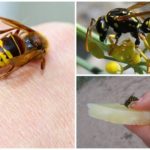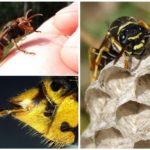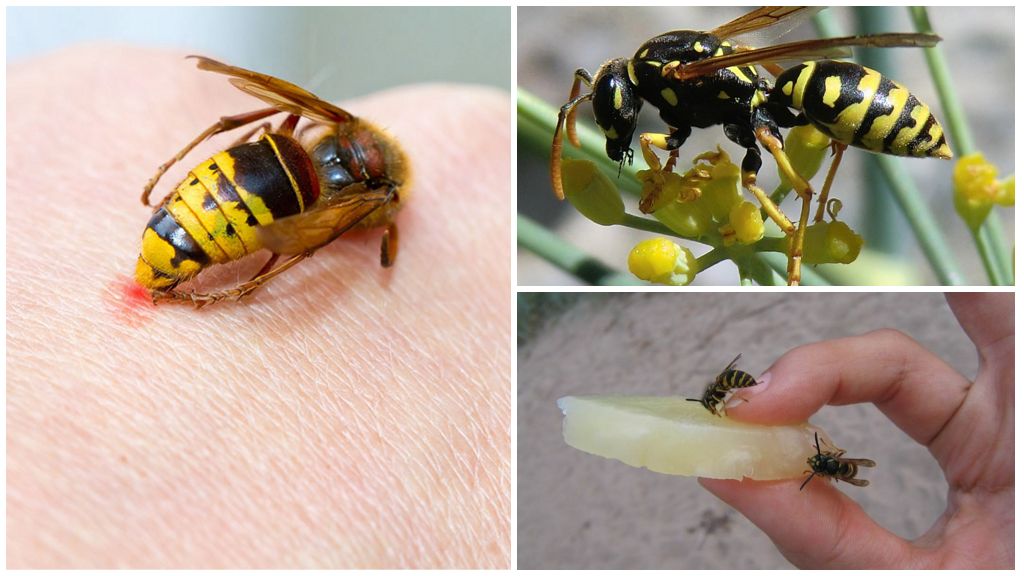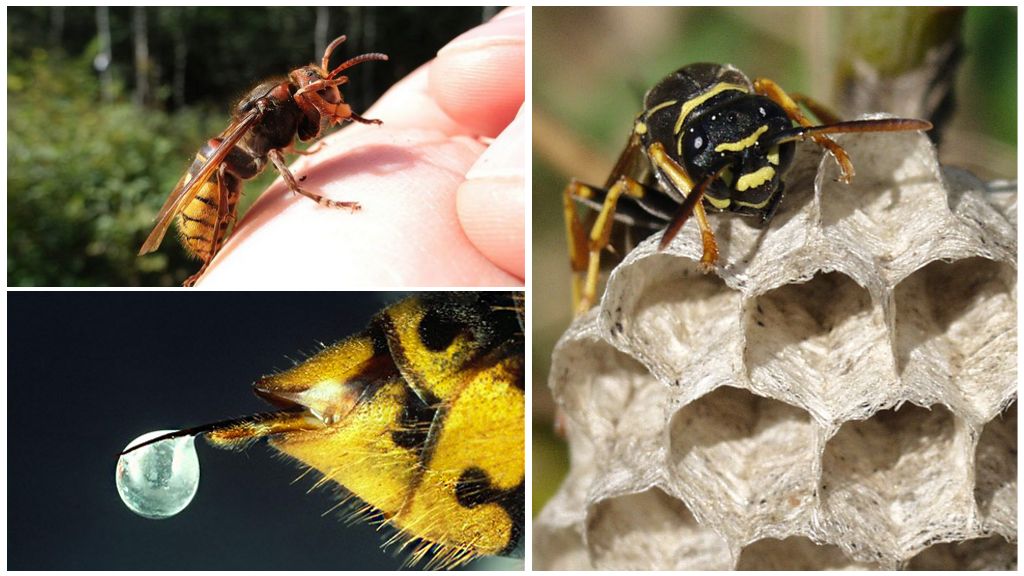What and how a wasp bites
Content
- Wasp sting
- Wasp sting
The sting of a wasp is a weapon that insects use to defeat a victim, to protect their own lives. It is a modified ovipositor, so the males lack such weapons for anatomical reasons. In view of the fact that female individuals predominate in the aspen family, it was felt that the wasps have a sting. In each species, it has an identical structure, but differs in the strength of the poison, which the insect injects when bitten.
Wasp bites or stings
The insect uses a sting in case of danger for its own life or during a hunt to paralyze the victim. After puncture of chitin or skin wasp quickly lets in poisonous substance.
However, if there is an opportunity to do without poison, the insect sets in motion powerful jaws. They have no teeth, but enough power to cut through the chitinous cover of beetles. The wasps try to save poison, use their weapons in case of emergency. In a fight with a man, insects always use a sting to protect them, which is why a statement has arisen that it was stinging. The word "bites" means exactly this process.
How wasp bites
Many types of wasps are distinguished by aggressive behavior, they rush to attack during sudden movements, when a person approaches. Unlike bees, wasps are able to sting several times - up to 5 per minute. Attacks until it can fly away. By whether there is a sting in the wound, you can find out who bitten, wasp or bee.
The aspen female sits on the body of the victim, cuts muscles, pulls out the sting, thrusts under the skin. The amount of poison in the blood depends on how deep it goes.Having pulled the weapon back, the insect is in no hurry to hide it, it is able to plunge several more times. How many times a wasp bites depends on the age of the insect, the species and the strength of the poison. Representatives of the social family put up to 5 bites at a time. A photo of the wasp's sting in the skin is presented below.
Interesting!
Wasps attack people to protect their lives, nest, larvae. If an inattentive, careless person finds himself near the wasp hive, he risks being bitten by a whole swarm. Insects living in a large family communicate with signals, if there is a danger, they notify others. In a matter of minutes, an entire swarm appears from whence arises, rushes to attack, can bite for several minutes.
When an insect leaves a sting when bitten
For wasps, this situation is unusual. The female quickly removes the weapon, rushes away. Even if it remains under the skin, the insect does not die, continues to live. The sting after a bite of a wasp remains at the site of injury if it was slapped during this process. The body disappeared, and the rod remained inside. The situation is rare, because intuitively a person looks like an insect or shakes his hand, foot,to get rid of it.
After bite leave the bee sting, because their weapons are different in structure, appearance. It has a lot of chipping, which allows it to easily pierce the skin, but does not allow to get back. To fly away, the bee makes a jerk, part of the abdomen comes off. Insect soon dieand abdomen remaining in place bite, continues to pulsate, supplying new portions of poison to the blood. For this reason, it should be removed as soon as possible.
Pulling the sting out of the wasp, if it still remains at the bite site, is very simple.
- Need to use a needle or tweezers. Tools should be wiped with alcohol, sanitized.
- In the first case, with a needle you can get it like a normal splinter, in the second - it is fixed at the base, gently pulled over.
- It is necessary to take out on millimeter. Otherwise, the wasp arms will break, some will remain under the skin.
On a note!
If the wasp's sting is not removed, nothing terrible will happen. Over time, the body itself spews a foreign body. The poison ceases to flow after the insect has flown away. If, on careful inspection, the needle was found at the site of the bite, it is necessary to get rid of it.After which you should squeeze the poison out of the wound. This will reduce pain, accelerate wound healing.
Axis weapon structure
You can carefully examine the sting of a wasp under a microscope. However, a thin needle sticking out of the abdomen is noticeable to the naked eye. A photo of the sting of the wasp is presented below.
It looks like a thin, sharp needle. Durable organ with duct inside. Connects with a poisonous gland. Sting after wasp sting expands, skips a portion of poison. In a quiet state, it hides in the abdomen, protected by special plates. With aggression, they expand, the needle travels out.
The walls are smooth, the tip is sharp. All in order to easily and quickly pierce the body of the victim. It is just as easy to pull back as it doesn’t have chipping like a bee has.
On a note!
Outwardly, the sting looks dark, almost black, in fact it is transparent.
Impact of poison of different wasps
The external structure of the protective weapon is identical in all species, but the strength of the poison and the behavior of insects differ significantly.
- The largest wasp - hornet, him bite very painful. Poison toxic. Asian Hornet able to kill allergies in just a few minutes. Annually in Japan, China, about 50 deaths after a hornet bite are recorded. The attack is compared with a puncture of the skin with a hot nail. Typical representatives of our area are less poisonous, but killing a person without providing timely medical care is capable of 5 bites of different individuals.
- The giant giants are impressive in their impressive size, and are among the largest species of wasps in the world. Have a small sting, non-toxic to humans poison. After a bite, there is a feeling of numbness, which passes within a few minutes. And only with an increased tendency to allergies, a local, systemic allergic reaction occurs. Skolia differ quiet temper, prefer to move away from a dangerous place, enemies, rather than attack. These insect species do not communicate with signals, do not build large nests, therefore the attack of a whole swarm is excluded.
- Filanta - the safest wasps, belong to digging, live underground. Not able to pierce human skin. You can crush them if necessary with your bare hands. The second name of insects - bee wolves. Large earthen wasps feed on bees and destroy the hive.Until maturity, the larva eats 5 adult bees. It has the ability to attack the victim on the fly. Sticks sting, paralyzing the bee. Then he squeezes the nectar, eats it, carries the prey to the nest. Forms a hive under the ground, well remembers its location.
- Pompilidae - a wasp with a long sting, a strong poison. Deals the most painful bites. Road wasps bite unbearably painful, attack at the first sign of aggression against him. Live around the world, more than 200 species inhabit the territory of Russia. The body size of an adult individual reaches 3 cm. They lead a solitary life, do not form a swarm, numerous nests. Eggs are laid on spiders, then the larvae eat the victim from the inside. Pompilidae have the most powerful, strong sting. Use it to attack the victim, the enemies.
If the insect managed to bite a person, it is necessary to wash the wound under running water, which will allow to wash off the particles of poison from the wound and disinfect. From allergies use hormonal, antihistamine.






 (votes: 4, Average rating: 4.25 out of 5)
(votes: 4, Average rating: 4.25 out of 5)


